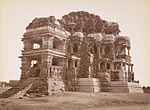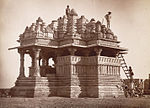- Mahipala I
-
- This article is about the Emperor Mahipala of Gurjara-Pratihara Dynasty. For the Pala Dynasty emperor, see Mahipala.
Mahipala I (913–944) was ascended to the throne of Gurjara-Pratihara dynasty after his step brother Bhoj II.[1] He was born of queen Mahidevi.[2] Mahipala I was also designated by names - Ksitipala, Vinayakapala, Herambapala and Uttarapatha Swami.[3]
Reign
It seems that Indra III's campaign did not influenced Kannauj much and Mahipala I soon revived Kannauj as court poet Rajasekhara calls him Maharajadhiraja of Aryavarta. According to Kavyamimansa[4] of Rajasekhara, Mahipala's reign extended from the upper course of the river Bias in the northwest to Kalinga or Orissa in the south-east, and from the Himalayas to the Kerala or Chera country in the far south.[5]
Mahipala occupied territories up to Narbada is evident from Partabgarh inscription, which inform about his son Mahendrapala II ruling at Ujjain in 946 AD. R. S. Tripathi asserts that as Mahendrapala II is not credited with any achievement so it must have been Mahipala I who recovered Ujjain.[6]
Closing days of Mahipala was again disturbed by attacks of Rashtrakutas on northern India as the Deoli and Karhad plates of Krisna III, while praising his achievement in the style of inflated panegyric, informs that by hearing conquest of southern regions, the hope about Kalanjara and Citrakuta vanished from the heart of the Gurjara.[7]
Arab chronicler Al-Masudi describes about Mahipala I as follows:
“ The ruler has four armies according to the four quarters of the wind. Each of them numbers 700,000 or 900,000 men. He has large armies in the garrisons on the north and on the south; on the east and on the west, for he is surrounded on all sides by warlike rulers.[8] ” Mahipala I, whom Kanarese poet Pampa expressly calls "Gurjararaja"[9], carried forward the work of his ancestors. He also built the Sas-Bhau temples in Gwalior which was devoted to God Vishnu (Sahastrabahu) but over the years known as Sas-Bahu temple.[10]
Sas Bhau ka Mandir
- Sas-Bahu temple
Sas-Bahu (Sahastrabahu) in the Gwalior Fort 

Sas-Bahu temple Small Sas Bahu temple These are twin temples adjoining each other both dedicated to God Vishnu (Sahastrabahu) but over the years got known as Sas-Bahu Temple. It was built by Raja Mahipal and got completed in 1093 A.D as per the Sanskrit inscription written. The doorway depicts trinity, i.e. Lord Bramha, Vishnu and Shiva. The temples are architectural marvels. Large slabs of sandstone are balanced over each other in slanting positions.[10][11]
Preceded by
Bhoj II (910–913)Gurjara Pratihara Emperor
913–944 CESucceeded by
Mahendrapala II (944–948)References
- ^ Radhey Shyam Chaurasia (2002). History of Ancient India: Earliest Times to 1000 A. D.. Atlantic Publishers & Distributors. p. 208. ISBN 812690027X,ISBN 9788126900275. http://books.google.co.in/books?id=cWmsQQ2smXIC&pg=PA208&dq.
- ^ Asni inscription
- ^ Rama Shankar Tripathi (1989). History of Kanauj: To the Moslem Conquest. Motilal Banarsidass Publ. p. 259. ISBN 812080404X, ISBN 9788120804043. http://books.google.co.in/books?id=2Tnh2QjGhMQC&pg=PA259&dq.
- ^ Kavyamimansa of Rajasekhara, ch. XVII, P. 94
- ^ Rama Shankar Tripathi (1989). History of Kanauj: To the Moslem Conquest. Motilal Banarsidass Publ. pp. 262–264. ISBN 812080404X, ISBN 9788120804043. http://books.google.co.in/books?id=2Tnh2QjGhMQC&pg=PA262&dq.
- ^ Rama Shankar Tripathi (1989). History of Kanauj: To the Moslem Conquest. Motilal Banarsidass Publ. p. 264. ISBN 812080404X, ISBN 9788120804043. http://books.google.co.in/books?id=2Tnh2QjGhMQC&pg=PA264&dq.
- ^ Rama Shankar Tripathi (1989). History of Kanauj: To the Moslem Conquest. Motilal Banarsidass Publ. p. 267. ISBN 812080404X, ISBN 9788120804043. http://books.google.co.in/books?id=2Tnh2QjGhMQC&pg=PA267&dq.
- ^ Rama Shankar Tripathi (1989). History of Kanauj: To the Moslem Conquest. Motilal Banarsidass Publ. pp. 268–269. ISBN 812080404X, ISBN 9788120804043. http://books.google.co.in/books?id=2Tnh2QjGhMQC&pg=PA268&dq.
- ^ Rama Shankar Tripathi (1989). History of Kanauj: To the Moslem Conquest. Motilal Banarsidass Publ. p. 222. ISBN 812080404X, ISBN 9788120804043. http://books.google.co.in/books?id=2Tnh2QjGhMQC&pg=PA222&dq.
- ^ a b "Places to visit in Gwalior, Vikramaditya Palace section". http://www.gwaliorhotels.net.in/places_to_see_in_gwalior.html.
- ^ "Monuments in Gwalior (Madhya Pradesh)". http://www.allindiatravelsinfo.com/monuments/monuments-in-gwalior.html.
Categories:- Gurjar
- Indian monarchs
- 944 deaths
- Year of birth uncertain
- Indian royalty stubs
Wikimedia Foundation. 2010.
